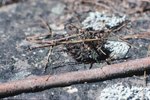
Warm summer weather brings cockroaches large and small out of the woodwork to zigzag crazily in and around your home in their quest to feed and breed. By contrast, the Madagascar hissing cockroach is a slow mover with a docile attitude that makes him a good pet. The difference between hissing roaches and house roaches doesn't stop there. They're also a lot less germy than their wild cousins when you keep them as pets.
A Product of Their Environment
House roaches survive in damp environments such as sewers, bathrooms and garbage cans. The roach grooms himself continually to rid himself of the bacteria, viruses and parasites he picks up along the way, but a roach's oily secretions and fecal matter leave plenty of germs behind. When you keep a hissing cockroach as a pet, he'll be bedding down and traveling over wood chips, spaghnum moss or other substrate that is far less conducive to bacterial growth than garbage or sewage. Remove uneaten food, exoskeletons and dead roaches regularly to prevent bacterial buildup.
Back to Nature
In the wild, hissing cockroaches live in the rain forests of Madagascar, seeking out dry leaf litter to burrow when they're not foraging. Their role in their environment is that of a detritivore, as they consume decaying vegetation and fruits, breaking it down through digestion and returning it to the ecosystem through their feces. Unlike house roaches, the hissing cockroaches do not seek out sewage or human habitations, preferring to keep to themselves in the relatively clean shadows of the forest.
Spreading Germs and Disease
Cockroaches commonly found in the home -- such as the sewer-dwelling giant American cockroach and garbage-loving German brown cockroach -- transmit more than 30 types of bacteria as well as parasites and viruses. By contrast, the hissing cockroach is not associated with the spread of disease, but like his house-dwelling cousins carry mold spores that trigger allergies or asthma attacks. Teach children not to rub their eyes or nose when handling the insects and have everyone wash their hands immediately afterward.
Mite be Nice
While cleaner than house roaches, hissing roaches come with their own set of issues. Keep your cage free of uneaten food, old exoskeletons and other debris to prevent attracting mites. While mites are common in their natural environment, they can be annoying additions to your habitat. The mites eat small food particles off your roach's exterior and do not bite or suck the body fluids of roaches or humans. Give your roach a flour bath to remove the mites, then rinse him off with a spray bottle.
References
Photo Credits
-
Jupiterimages/Photos.com/Getty Images
Writer Bio
Indulging her passion for vacation vagary through the written word on a full-time basis since 2010, travel funster Jodi Thornton-O'Connell guides readers to the unexpected, quirky, and awe-inspiring.




